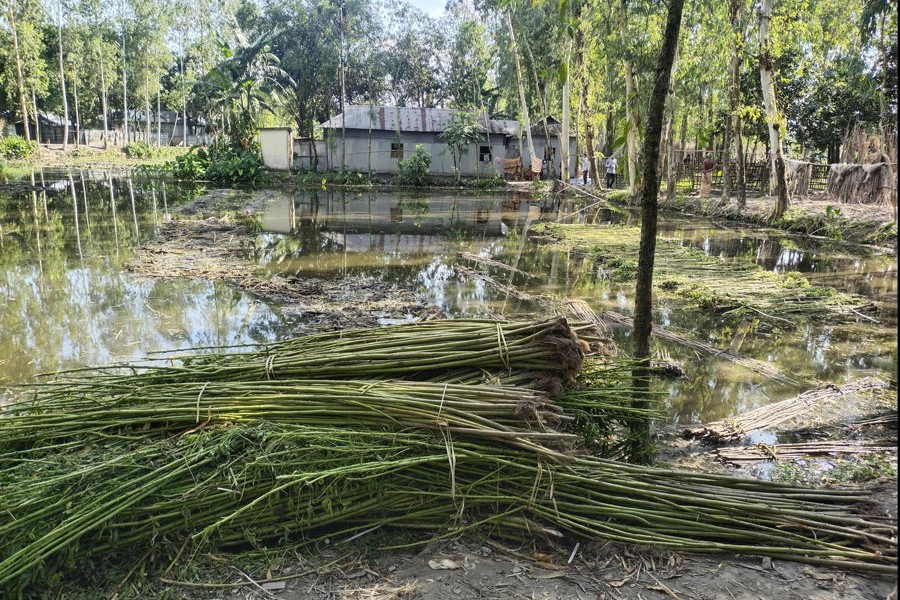
Water scarcity hits jute retting in dists
Low price upsets growers, crop acreage on decline
OUR CORRESPONDENTS | Friday, 2 August 2024

Retting of jute plants is being hampered much to the frustration of farmers due to scarcity of water as rivers, canals, ditches and ponds are running dry in the current season in Pabna, Gaibanda, Rangpur, Lalmonirhat and Chandpur districts.
In the present situation, farmers are not able to harvest raw jute though it is the appropriate time for the retting process. Consequently, there lies a danger of the jute plants drying up in the very fields.
Moreover, being deprived of the fair price, farmers are moving away from cultivation of the crop, once called golden fibre of the country.
FE correspondent from Pabna reports: Despite production of jute on a record amount of land in the district this season, farmer cannot yet rot jute plants for want of water.
Even during the current Ashar-Sraban season of the monsoon, rivers, canals, ponds and reservoirs here are empty of water.
Farmers are in apprehension that if jute plants cannot be properly rotten, there is a risk of the fiber quality deteriorating.
As there is no sufficient water in the local sources like canals and lakes, the farmers have to work extremely hard to manage the raw jute processing; and the problem has been continuing for the past several years.
Haran Ali, a farmer of Malanchi village in Sadar upazila, said that he cultivated jute on two bighas of land this year. As the production cost is high, the fair price is elusive and there is difficulty in rotting row jute for inadequacy of water every year, they are forced to reduce its farming gradually.
Jahurul Islam, a jute farmer of Naranpur village in sadar upazila, said that due to increase in prices of fertiliser and pesticides and labourers' wage, jute cultivation is not profitable as expected. Besides, unavailability of space and lack of water hider the jute retting process.
Deputy Director of the Department of Agricultural Extension (DEA), Pabna, Dr Jamal Uddin told The Financial Express, "In nine upazilas of the district, jute was cultivated on 43,762 hectares of land this season aiming to produce 5,96,113 tones of the crop.
He further said that due to the water scarcity, the farmers have to struggle. He recommended jute rotting by lifting water through borehole irrigation although this may reduce the quality of fibre.
In Gaibandha, jute cultivation in the district has been limited to 13,000-14,000 hectares of land for the past few years. The reason is that during jute planting, usually there is scanty rainfall leading to a scarcity of water, eventually hampering cultivation.
Besides, as the price is not fair often, the farmers are not interested in jute cultivation.
Likewise, jute retting process is also being seriously hampered in the district for unavailability of water.
According to the DAE, Gaibandha, jute has been cultivated on 13,790 hectares of land in the district this season against 14, 313 hectares last year. And compared to last year the farming has decreased by 523 hectares.
Farmer Vijay Chandra of Goailbari village in sadar upazila told the FE that he has cultivated jute on 20 hectares of land. Production is good but he is worried about the price.
In Rangpur, the prevailing drought-like situation casing scarcity of water is delaying the process of jute plants rotting much to the worry of the farmers.
Rainfall occurs seldom to the famers' relief and they rot the jute plants with water as much as they can stock.
According to the DAE, Rangpur, jute has been cultivated on 9,530 hectares of land in eight upazilas of the district this season. Last year the crop was cultivated on 9,425 hectares of land marking an increase by 105 hectares year on year.
In Lalmonirhat, unavailability of water in ponds, cannels and other water bodies is creating difficulties in rotting jute fibre in many areas.
Water levels in most of the water bodies and cannels have fallen sharply as hot and sunny weather are prevailing in these areas.
For want of suitable water and rotting facilities, jute fibre quality is diminishing, worrying the growers.
Aminul Islam, a farmer of Mahendranagar village in sadar upazila, said due to lack of water, arrangements have to be made to rot jute by collecting water through irrigation, which is expensive and difficult for everyone.
According to the local Jute Development Centre, farmers cultivated jute on 3,940 hectares of land in the district this season, which was 3,995 hectares last year.
In Chandpur, because of the low price trend, cultivation of jute is decreasing in Chandpur district. Last year, jute was cultivated on 3,693 hectares of land.
This year, the target of jute cultivation (all types) was fixed on 3,857 hectares of land in the district but jute has been cultivated on 3,624 hectares.
Babul Gazi, a farmer of Krishnapur village of the district, said they were not getting fair price by selling jute in the open haats and bazars. So, this year, they were not interested to cultivate jute.
motiarfe@gmail.com
atik.mms2014@gmail.com
sayedmofidulbabu@gmail.com
ahasnathrana@yahoo.com
maayerbadhon@gmail.com